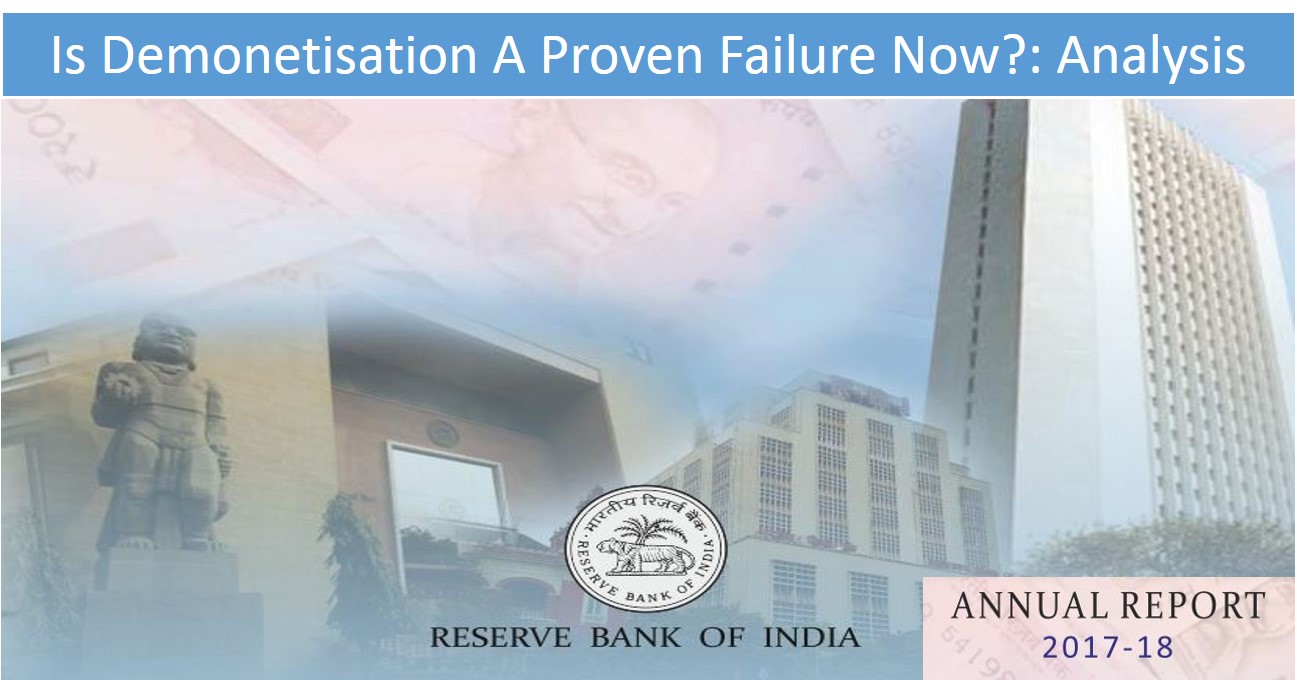The Reserve Bank of India Annual Report 2017-18 highlights many aspects of impact of demonetisation on Indian Economy. Here is an in-depth analysis of the targets and achievements of Demonetisation in India.
The Reserve Bank of India in its Annual Report has said Rs15.31 lakh crore out of the total Rs 15.41 lakh crore demonetised currency returned to the banking system. The Apex body also said that 99.3 per cent junked notes were deposited in banks, while 0.7 per cent notes worth Rs10,720 crore couldn’t be detected.
Highlights of RBI Annual Report 2017-18:
- The value of banknotes in circulation increased by 37.7 per cent over the year to Rs 18.03-lakh crore at end-March 2018. The volume of banknotes, however, increased by 2.1 per cent. This is in sharp contrast to the government’s push for digitisation and a less-cash economy.
- In terms of value, the share of Rs500 and Rs2,000 banknotes, both of them accounted for 72.7 per cent of the total value of banknotes in circulation in March-end 2017, that increased to 80.2 per cent in March-end 2018.
- The after-effects of demonetisation continued in 2017-18 as well. The RBI says the indent for 2017-18 was higher by 9.1 per cent as compared to last year. However, the supply of banknotes was lower than the previous year.
- During the year, 2,700 crore pieces of banknotes were disposed off as against 1200 crore pieces last year, mainly on account of accelerated processing of Rs 500 and Rs 1,000 notes. The RBI said the huge task of currency management, including remonetisation, processing and reconciliation, was achieved in record time.
According to the RBI data, 522,783 pieces of fake notes were detected in the banking system in 2017-18.
- Of the total fake notes detected, the share of such notes detected by the central bank was higher at 36.1 per cent in 2017-18 as compared to 4.3 per cent during the previous year.
- The total expenditure incurred on security printing during the FY18 stood at Rs 4,912 crore as against Rs 7,965 crore in 2016-17, says the RBI.
Achievements of Demonetisation
Target of Demonetisation
Finance Ministry indicated in a press release issued recently that the demonetisation is on course to meet its objectives. The ministry also listed down the target of the demonetisation exercise:
• Flushing out black money
• Removal of fake Indian Currency Notes
• To strike at the root of financing of terrorism and left wing extremism
• Converting informal economy into a formal economy to expand tax base
• A big boost to digitalization of payments to make India a cashless economy.
Was Demonetisation Good or Bad for Economy?
Now the question is that if the demonetisation was either good or bad for the economy?
Demonetisation had a two-fold impact on the Indian economy:
An aggregate demand shock by reducing the supply of money, and, an aggregate supply shock by constraining availability of cash as a critical input for specified economic activities, such as purchase of inputs in the agriculture sector. Growth slowed down to a four-year low of 6.7%.
Demonetisation led to disruptions in economic and industrial activity like the lower GDP growth in the past two years.
Soon after demonetisation in November 2016, sales of consumer durables and appliances slipped by 40%.
The negative impact of demonetisation was felt across the all segments of economy, especially agriculture and industry. The worst impacted were segments that relied on high-volume cash transaction, such as organized and unorganized retail. The impact was felt at both the firm level as well as at the consumer level. The report also states that the disruption caused by cash shortages dampened consumer and business sentiments, leading to a decline in high-frequency consumption and production indicators, such as sales of two-wheelers and cement output, respectively.
Even in agriculture, demonetisation aggravated the sector’s existing stress points by creating new choke points within the supply-chain. Cash is a critical input in the agricultural production process and its unexpected shortage had an impact at many levels, including a slowdown in employment of labour and a dip in overall farm incomes.
Full Report by RBI can be accessed here
